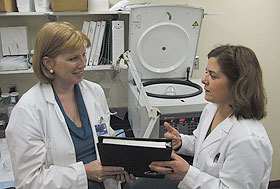  |
| HOME | THIS ISSUE | CALENDAR | GRANTS | BACK ISSUES | < BACK | NEXT > |
Study finds nicotine gum helps women who smoke during pregnancyby Chris DeFrancesco - October 27, 2008
|
||||
| Smokers who use nicotine gum during pregnancy are likely to smoke fewer cigarettes and reduce their risk of having a low-birth-weight or premature baby, according to research led by Dr. Cheryl Oncken, associate professor of medicine and obstetrics and gynecology at the UConn Health Center. A study published Oct. 1 in the journal Obstetrics & Gynecology compared birth outcomes of smokers who during pregnancy used either nicotine gum or a placebo gum, and found that the offspring of the nicotine-gum users had a better average birth weight and gestational age. “The decreased risk of low birth weight and preterm delivery associated with nicotine-replacement therapy is clinically important,” Oncken writes. “With the prevalence of smoking in pregnant women being 12 percent, a modest reduction in the risk of low birth weight and premature delivery can, in the aggregate, be very great.” Lowering the premature delivery rate could result in cost savings by lowering neonatal intensive care unit admissions and infant length of stay, she adds. The nearly 200 study participants smoked an average of 18 cigarettes per day before pregnancy and 10 cigarettes per day in the week leading up to the study, which was supported by the National Institute on Drug Abuse and the Lowell P. Weicker Jr. General Clinical Research Center at the UConn Health Center. “There was a modest increase in cessation rates in both groups,” Oncken says. “Those who had the nicotine gum showed an 18 percent quit rate, while the placebo group showed a quit rate of 15 percent. More noticeable than that was a decrease in average daily cigarette use. The nicotine gum users smoked almost six fewer cigarettes a day, while the placebo group cut back by three and a half cigarettes.” Oncken’s research partners included Health Center colleagues Ellen Dornelas, associate professor of medicine, Dr. John Greene, associate professor of obstetrics and gynecology, and Dr. Henry Kranzler, professor of psychiatry. The study was a collaborative effort between the Health Center, Hartford Hospital, New Britain General Hospital (now known as the Hospital of Central Connecticut), Yale School of Medicine, and Baystate Medical Center.
The participants received two smoking cessation counseling sessions, were given a supply of gum, and were instructed to chew one piece for every cigarette they usually smoked per day. The women in the “nicotine” group were given two-miligram nicotine gum, while the women in the placebo group got a nicotine-free gum in packaging that mimicked the nicotine gum. In addition to the findings on gestational age and birth weight, Oncken noted that the study showed a trend for other differences in birth outcomes favoring the nicotine gum users, including neontatal length (the newborn’s height), head circumference, Apgar scores (an assessment of neonatal well-being), infant length of stay, and neonatal intensive care unit admissions. But Oncken describes those findings as not statistically significant. “It’s important to examine treatments that may help pregnant women quit smoking or reduce their tobacco exposure, especially when these treatments are available for purchase over the counter and may be used in prenatal care,” Oncken says. “Smoking is the most modifiable risk factor for poor pregnancy outcomes in the United States.” The study cites previous research that concludes smoking doubles the risk of delivering a low-birth-weight or premature infant, and that tobacco smoke contains more than 3,500 chemicals, many of which can threaten fetal development. An abstract of Oncken’s study is available at http://www.greenjournal.org/cgi/content/abstract/112/4/859 |
| ADVANCE HOME UCONN HOME |

